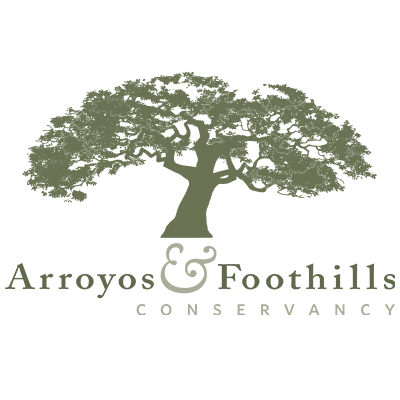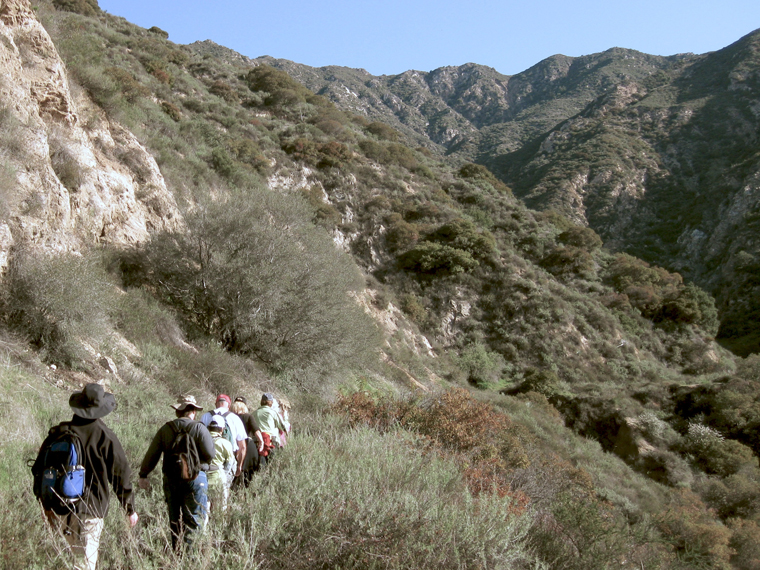Rubio Canyon Habitat & Wildlife
When AFC acquired Rubio Canyon in 2011, much of the canyon’s habitat had been degraded by invasive species. Now, AFC is slowly curtailing the prevalence of invasive plant species in the canyon. The work is being carried out by professional groups, including the California Conservation Corps and Los Angeles Conservation Corps, along with volunteer groups from the Neighborhood Church, Polytechnic School, REI, Westridge School among others.
Habitat and Plant Communities
The dominant plant communities within and adjacent to the canyon form a diverse mosaic consisting of chaparral, coastal sage scrub, coast live oak woodland, and riparian. The southern edge contains alluvial scrub interspersed with isolated western sycamores (Platanus racemosa) and Fremont cottonwood (Populus fremontii). The habitat found in Rubio Canyon is contiguous with riparian woodland habitats north into the Angeles National Forest and largely contiguous with riparian, oak woodland and ephemeral wash habitat located southwest towards developed areas of Altadena. The undeveloped foothill and mountainous terrain within the Angeles National Forest to the north is core habitat for large mammals and birds that currently utilize Rubio Canyon as a corridor for accessing suitable habitat. To date, over 126 species of plants have been identified on the property and a list of invasive, non-native plants has been created for targeted removal as part of a habitat restoration program.
Wildlife, Movement and Landscape Connectivity
Wildlife movement within and through the parcel consists of daily as well as seasonal patterns for both large and small vertebrates. The shaded canyon bottoms with seasonal stream flow provide the most important corridor for all wildlife species.
Mammals
While hiking the trails it is common to encounter mule deer (Odocoileus hemionus) feeding along the adjacent slopes. Sightings and camera trap photos of black bear (Ursus americanus) and mountain lion (Puma concolor), Bobcat (Lynx rufus), coyote (Canis latrans) indicate a diverse and healthy mammal community. Western gray squirrels (Sciurus griseus) and California ground squirrels (Spermophilus beecheyi) are observed moving through the dense oak woodland. The canyon funnels wildlife between habitats within the Angeles National Forest down to the lowland habitat within Altadena.
Birds
Currently, about 85 species of birds have been recorded on the Rubio Canyon property, and lists documenting these have been entered by birders into the eBird public database. Regularly seen species include: red-tailed hawk, band-tailed pigeon, mourning dove, Anna’s and Allen’s hummingbirds, acorn woodpecker, Nuttall’s woodpecker, western wood-pewee, Pacific-slope flycatcher, black phoebe, ash-throated flycatcher, California scrub-jay, American crow, common raven, oak titmouse, bushtit, canyon, Bewick’s, and house wren, wrentit, Northern mockingbird, phainopepla, warblers including orange-crowned, yellow-rumped, black-throated gray, and Townsend’s, spotted towhee, California towhee, song sparrow, dark-eyed junco, black-headed grosbeak, house finch, and lesser goldfinch. Owls, including Western Screech and Great Horned are resident.
Amphibians and Reptiles
The most common reptiles known from Rubio Canyon are side-blotched lizard, Western fence lizard, Western whiptail lizard and San Diego alligator lizard, gopher snake, California striped racer, two-striped garter snake, and Pacific rattlesnake. Amphibians found include western newt, black-bellied slender salamander, pacific chorusfrog, California chorusfrog, and western toad. Additional species of amphibians and reptiles that have been recorded in the vicinity along the foothills of the San Gabriel mountains are likely present. These include Monterey salamander, patch-nosed snake, California kingsnake, California mountain kingsnake, rosy boa, Western blind snake (rare) and ring-necked snake.
Invertebrates
Several hundred species of invertebrates, including insects are expected to utilize the varied habitats on the property. Butterflies especially add interest and color to any site visits.



